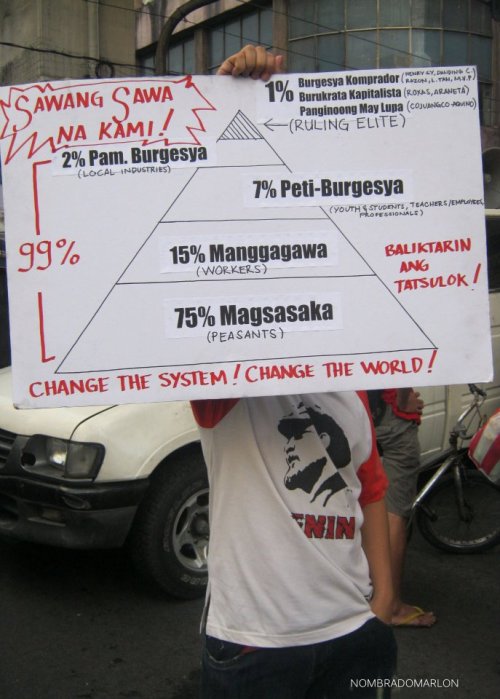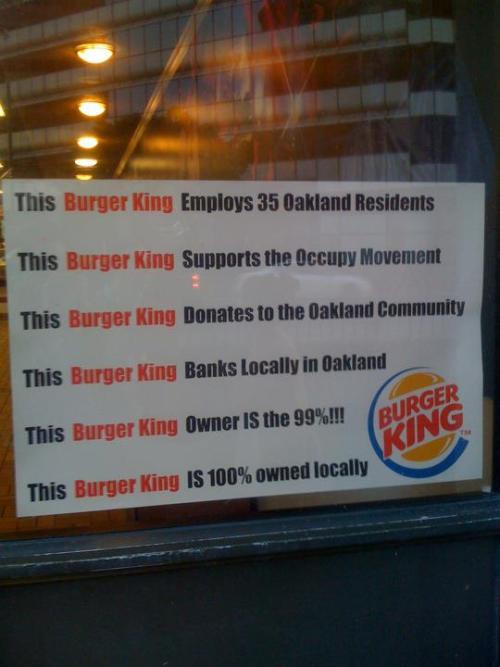
(from the condition of postmodernity by david harvey)
Clearly the occupy movement is a perfect paragon of the pomo paradigm!
Racism in the Occupy movement
When formal hierarchies are attacked and dismantled, oppressive social power doesn’t disappear, it intensifies along informal social hierarchal lines. This was critiqued by Jo Freeman in her essay “The Tyranny of Structurelessness”:
Contrary to what we would like to believe, there is no such thing as a structureless group. Any group of people of whatever nature that comes together for any length of time for any purpose will inevitably structure itself in some fashion. The structure may be flexible; it may vary over time; it may evenly or unevenly distribute tasks, power and resources over the members of the group. But it will be formed regardless of the abilities, personalities, or intentions of the people involved. The very fact that we are individuals, with different talents, predispositions, and backgrounds makes this inevitable. Only if we refused to relate or interact on any basis whatsoever could we approximate structurelessness -- and that is not the nature of a human group.
Critical thinkers need to look at the hidden structure behind the occupations. Due to the nature of the occupations and the societies they operate in, these structures are broadly white supremacist and sexist, with local variations.
http://www.racialicious.com/2011/10/05/an-open-letter-from-two-white-men-to-occupywallstreet/
According to the main websites associated with #OccupyWallStreet, it is “one people, united,” a “leaderless resistance movement with people of many colors, genders and political persuasions,” and an “open, participatory and horizontally organized process.” In other words, it professes to be the universal protest against the greed and corruption rampant in our society, open for anyone to join and shape.
But a quick survey of the movement so far shows that that the good intentions outlined do not reflect the reality of the situation. There is indeed an organizational structure and a core group that makes leadership decisions in #OWS (and we think this is a good thing). They are the media team at the media command center, the committee facilitators and the people who have been actually occupying the park for the past three weeks. One only needs to take a good look around to see that the leadership and the core group—which has managed to attract enormous national and international media attention—is overwhelmingly white (and largely male), and as a result the voices and perspectives of #OccupyWallStreet reflect that reality more generally.
…
One striking example of the marginalization of non-white voices within the movement was seen at the march on Friday against police brutality. Because this march was organized by activist groups in conjunction with #OWS, it was by far the most diverse rally yet. But towards the end of the march, when organizers were speaking to the group at One Police Plaza, a black woman near the speakers was clearly agitating for her voice to be heard. Despite the line of white people speaking before her, a white #OWS organizer spoke to the crowd and informed them that within a few minutes, the march would be over and everyone should leave peacefully. Of course, that meant that as soon as he was finished speaking everyone got up to leave. As the black woman (the lone black voice speaking in a march against police brutality) got up to speak, her voice was lost because by that point no one was paying attention.
In this case, the marginalization was not intentional: a PSA was made to inform people to ensure the rally’s peaceful closure. But most racial marginalization is indeed “unintentional.” In this case the silenced black woman was going to speak about her close relative, who was killed by police. She was the only person speaking with a personal relationship to police brutality at a level almost unimaginable to the people occupying Zucotti Park, and her voice was not heard.
The 99% rhetoric ignores wildly divergent class interests
One picture symbolizes this especially well:

Broad American Populism = White Supremacy

Notions of broad American populism are popular on the white “left”, but nearly all the gains from broad American populism go to a privileged strata of white people. When radicals divorce the 99% rhetoric from the history of American populism, they are ignoring how that broad rhetoric has been used to exclude the needs of the disenfranchised. Without a POC-centered strategy, nothing is stopping the ruling class from using the same tools to reduce class tensions. The biggest threat to the occupy movement isn’t cops or cold weather, it’s the dropping white unemployment rate. My prediction is that the same thing will happen to OWS as what happened with its fraternal twin, the Tent City movement in Israel. after the white radicals get bored or get jobs, the only people left will be those most vulnerable, then the cops can sweep in and remove them without anyone giving a shit.
http://www.pbs.org/race/000_About/002_04-background-03-02.htm
Less known are more recent government racial preferences, first enacted during the New Deal, that directed wealth to white families and continue to shape life opportunities and chances today.
The landmark Social Security Act of 1935 provided a safety net for millions of workers, guaranteeing them an income after retirement. But the act specifically excluded two occupations: agricultural workers and domestic servants, who were predominately African American, Mexican, and Asian. As low-income workers, they also had the least opportunity to save for their retirement. They couldn't pass wealth on to their children. Just the opposite. Their children had to support them.
Like Social Security, the 1935 Wagner Act helped establish an important new right for white people. By granting unions the power of collective bargaining, it helped millions of white workers gain entry into the middle class over the next 30 years. But the Wagner Act permitted unions to exclude non-whites and deny them access to better paid jobs and union protections and benefits such as health care, job security, and pensions. Many craft unions remained nearly all-white well into the 1970s. In 1972, for example, every single one of the 3,000 members of Los Angeles Steam Fitters Local #250 was still white.
But it was another racialized New Deal program, the Federal Housing Administration, that helped generate much of the wealth that so many white families enjoy today. These revolutionary programs made it possible for millions of average white Americans - but not others - to own a home for the first time. The government set up a national neighborhood appraisal system, explicitly tying mortgage eligibility to race. Integrated communities were ipso facto deemed a financial risk and made ineligible for home loans, a policy known today as "redlining." Between 1934 and 1962, the federal government backed $120 billion of home loans. More than 98% went to whites. Of the 350,000 new homes built with federal support in northern California between 1946 and 1960, fewer than 100 went to African Americans.
These government programs made possible the new segregated white suburbs that sprang up around the country after World War II. Government subsidies for municipal services helped develop and enhance these suburbs further, in turn fueling commercial investments. Freeways tied the new suburbs to central business districts, but they often cut through and destroyed the vitality of non-white neighborhoods in the central city.
Today, Black and Latino mortgage applicants are still 60% more likely than whites to be turned down for a loan, even after controlling for employment, financial, and neighborhood factors. According to the Census, whites are more likely to be segregated than any other group. As recently as 1993, 86% of suburban whites still lived in neighborhoods with a black population of less than 1%.
Reaping the Rewards of Racial Preference
One result of the generations of preferential treatment for whites is that a typical white family today has on average eight times the assets, or net worth, of a typical African American family, according to New York University economist Edward Wolff. Even when families of the same income are compared, white families have more than twice the wealth of Black families. Much of that wealth difference can be attributed to the value of one's home, and how much one inherited from parents.
But a family's net worth is not simply the finish line, it's also the starting point for the next generation. Those with wealth pass their assets on to their children - by financing a college education, lending a hand during hard times, or assisting with the down payment for a home. Some economists estimate that up to 80 percent of lifetime wealth accumulation depends on these intergenerational transfers. White advantage is passed down, from parent to child to grand-child. As a result, the racial wealth gap - and the head start enjoyed by whites - appears to have grown since the civil rights days.
Since Occupy cannot escape its pomo prison, it is likely that all the benefits will only go to the pale, pasty protesters and not those who need it the most.
